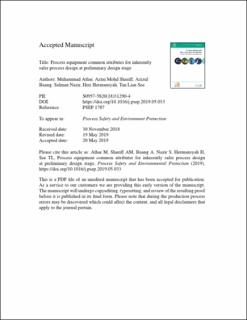| dc.contributor.author | Athar, Muhammad | |
| dc.contributor.author | Shariff, Azmi Mohd | |
| dc.contributor.author | Buang, Azizul | |
| dc.contributor.author | Nazir, Salman | |
| dc.contributor.author | Hermansyah, Heri | |
| dc.contributor.author | See, Tan Lian | |
| dc.date.accessioned | 2020-04-21T08:20:24Z | |
| dc.date.available | 2020-04-21T08:20:24Z | |
| dc.date.created | 2019-06-23T18:09:49Z | |
| dc.date.issued | 2019 | |
| dc.identifier.citation | Process Safety and Environmental Protection. 2019, 128 14-29. | en_US |
| dc.identifier.issn | 0957-5820 | |
| dc.identifier.uri | https://hdl.handle.net/11250/2651798 | |
| dc.description.abstract | Hazards associated with chemical processes can lead to accidents and require therefore proper management. An inherent safety strategy is a proactive approach to serve this purpose, one capable of minimizing hazards whilst offering sustainable process design. Current inherent safety techniques are limited to comparing process routes and selecting safer one using the process parameters, whereas process equipment characteristics are rarely scrutinized. Therefore, this paper consolidates a new technique that integrates the mutually shared attributes of process equipment, in order to offer inherently safer process design at the preliminary design stage. Inherent safety assessment for process equipment (ISAPE) consists of an indexing procedure, followed by risk assessment. The indexing procedure can highlight the critical process equipment, which can be further studied through risk assessment. When the risk is beyond acceptable threshold and must be minimized, inherent safety concepts are implemented, leading towards inherently safer process design. The complete ISAPE technique is exhibited through the case study of the acetone production process. In this case study, various ISD options have been applied to the critical process equipment, identified through the proposed indexing; the options have then been compared to select the best one. The method is easy to use, and as such, it is suitable to be put into practice by design engineers at the preliminary design stage. | en_US |
| dc.language.iso | eng | en_US |
| dc.rights | Attribution-NonCommercial-NoDerivatives 4.0 Internasjonal | * |
| dc.rights.uri | http://creativecommons.org/licenses/by-nc-nd/4.0/deed.no | * |
| dc.title | Process equipment common attributes for inherently safer process design at preliminary design stage | en_US |
| dc.type | Peer reviewed | en_US |
| dc.type | Journal article | en_US |
| dc.description.version | acceptedVersion | en_US |
| dc.source.pagenumber | 14-29 | en_US |
| dc.source.volume | 128 | en_US |
| dc.source.journal | Process Safety and Environmental Protection | en_US |
| dc.identifier.doi | 10.1016/j.psep.2019.05.033 | |
| dc.identifier.cristin | 1707080 | |
| cristin.ispublished | true | |
| cristin.fulltext | postprint | |
| cristin.qualitycode | 1 | |

